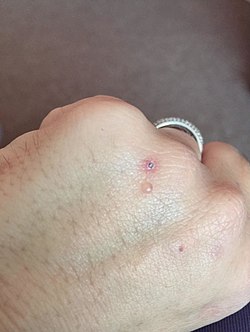
Back برفيرية جلدية آجلة Arabic Porfirija cutanea tarda BS Porphyria cutanea tarda German Porfiria cutánea tarda Spanish Larruazaleko porfiria berantiar Basque Porfirija cutanea tarda Croatian Porphyria cutanea tarda Dutch Porfiria cutânea tardia Portuguese Касна кожна порфирија Serbian
| Porphyria cutanea tarda | |
|---|---|
| Other names | PCT |
 | |
| Blister on the hand of a person with porphyria cutanea tarda | |
| Specialty | Endocrinology |
Porphyria cutanea tarda is the most common subtype of porphyria.[1] The disease is named because it is a porphyria that often presents with skin manifestations later in life. The disorder results from low levels of the enzyme responsible for the fifth step in heme production. Heme is a vital molecule for all of the body's organs. It is a component of hemoglobin, the molecule that carries oxygen in the blood.
Hepatoerythropoietic porphyria has been described as a homozygous form of porphyria cutanea tarda,[2] although it can also be caused if two different mutations occur at the same locus.
- ^ Phillips, J. D.; Bergonia, H. A.; Reilly, C. A.; Franklin, M. R.; Kushner, J. P. (2007). "A porphomethene inhibitor of uroporphyrinogen decarboxylase causes porphyria cutanea tarda". Proceedings of the National Academy of Sciences. 104 (12): 5079–84. Bibcode:2007PNAS..104.5079P. doi:10.1073/pnas.0700547104. JSTOR 25427147. PMC 1820519. PMID 17360334.
- ^ "porphyria cutanea tarda" at Dorland's Medical Dictionary
© MMXXIII Rich X Search. We shall prevail. All rights reserved. Rich X Search